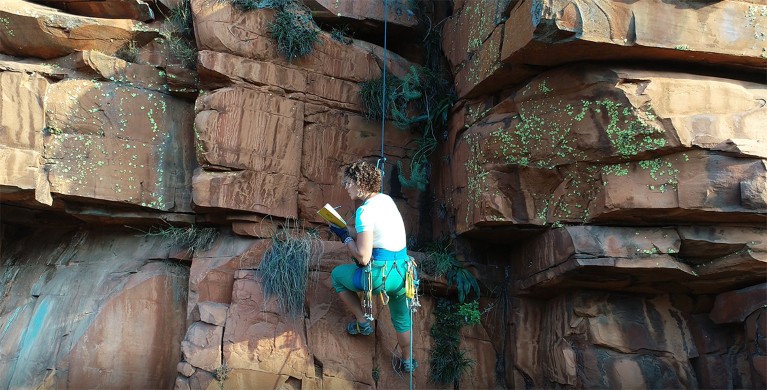I study how plants adapt to some of the most extreme conditions on Earth. My particular focus is the South African ‘resurrection’ plant (Myrothamnus flabellifolia), which can survive for years in a completely desiccated state. Understanding what makes these plants so resilient could help us to develop crops that will survive drought.
I often travel to the Buffelskloof Nature Reserve, in the Mpumalanga province of South Africa, to measure and take samples of M. flabellifolia that grow there, on a 100-metre quartzite cliff. In this picture, where I’m about about to abseil down it, I’m recording the plants’ height, sex, number of flowers, hydration status and soil depth. I aim to understand how their structure, life history and drought tolerance change over time, and with distance up the cliff face.
I’d been rock climbing for more than a decade before I began researching these plants. I never had any formal training in abseiling, but friends and mentors taught me the basics, and I learnt through experience. I’ve broken both ankles and once fell 15 metres before the rope caught me.
At some point, I realized that I could use my abseiling skills to reach rarely studied plant communities in extreme habitats. I’ve found that the flowers of M. flabellifolia are also desiccation-tolerant and that the plant dries at different rates on the cliff, depending on light exposure and on the depth and water-holding capacity of the soil.
My field site is 1,700 kilometres from my laboratory. It’s a two-hour flight from my lab to the closest airport, in Johannesburg. Then I have to drive for 4.5 hours. In daylight, the rock surface at the site is at least 40 °C, and tools will burn your hand — and I can’t always get the equipment and supplies I need.
Last November, I had to drive about 40 kilometres to get dry ice to freeze some samples. I’d forgotten my wallet, but the shopkeeper said I could pay next time. That was incredibly heart-warming.


 Birds that make the heart sing
Birds that make the heart sing
 How a Nigerian biochemist hopes to stop the spread of sleeping-sickness disease
How a Nigerian biochemist hopes to stop the spread of sleeping-sickness disease
 Desiccation tolerance: Seedy origins of resurrection
Desiccation tolerance: Seedy origins of resurrection







